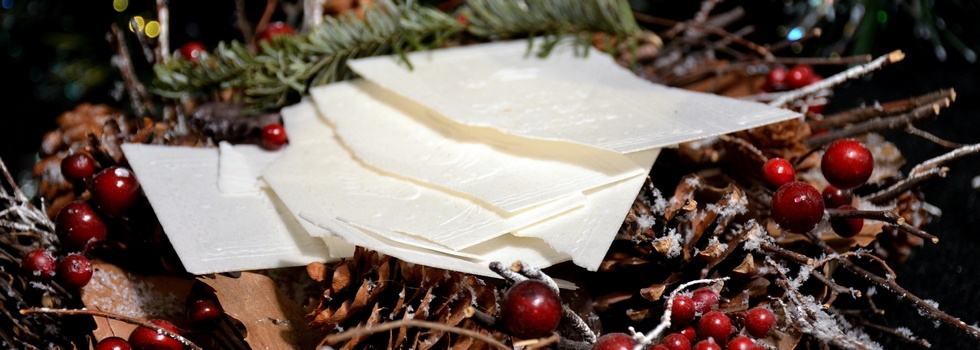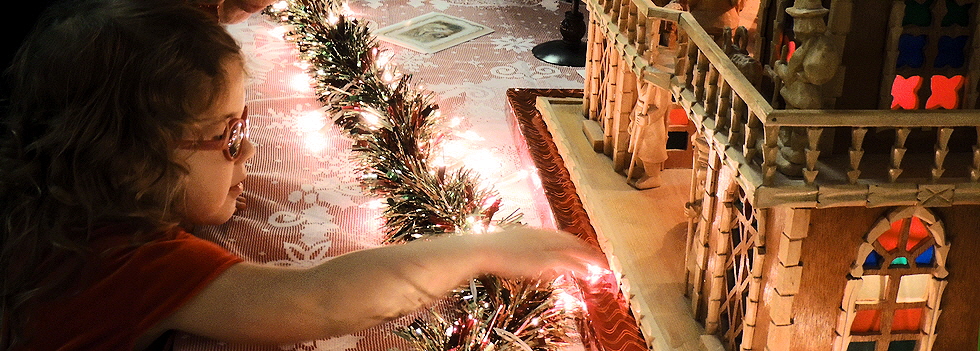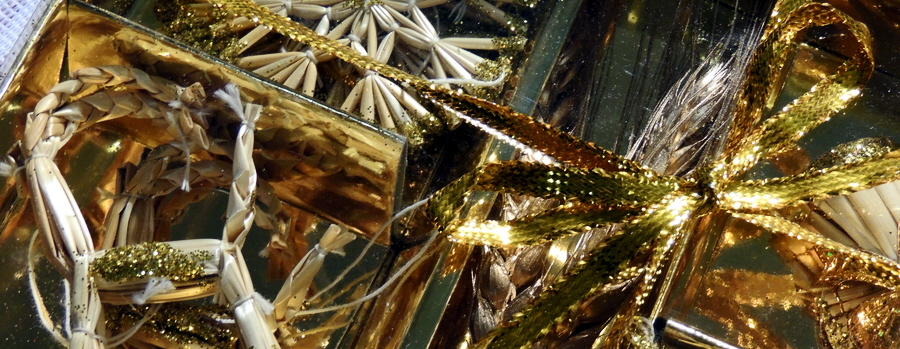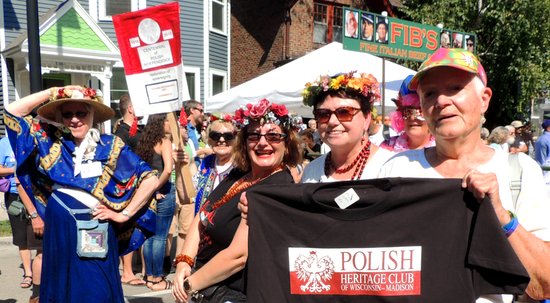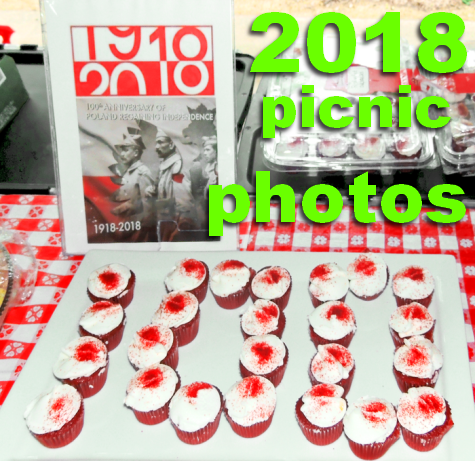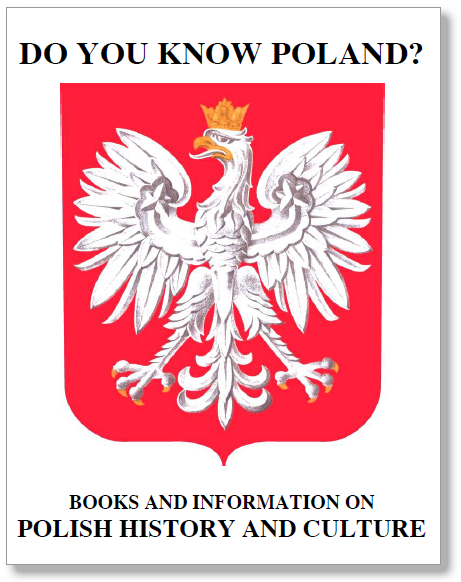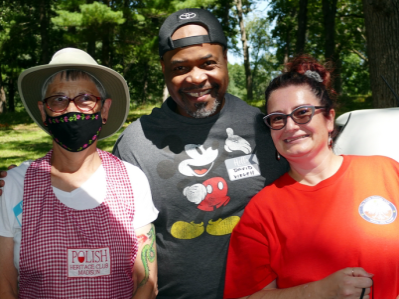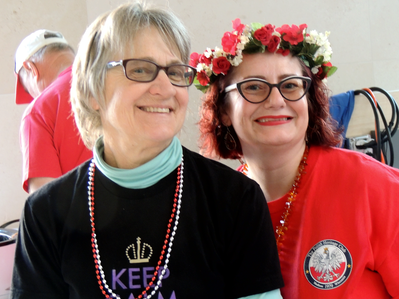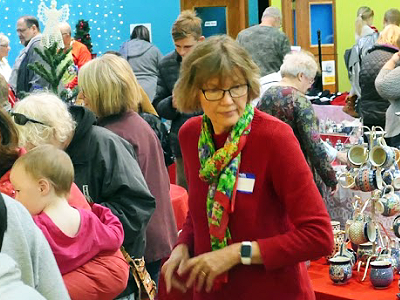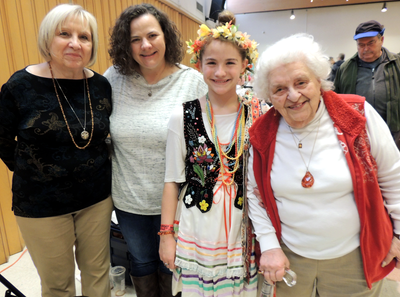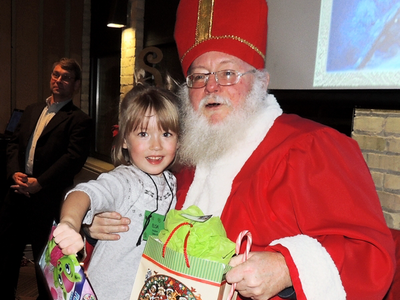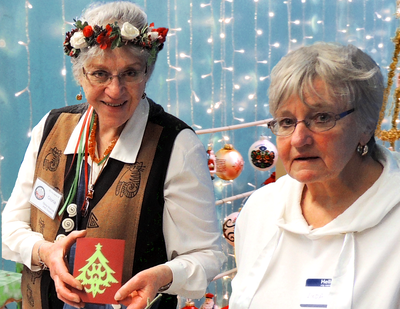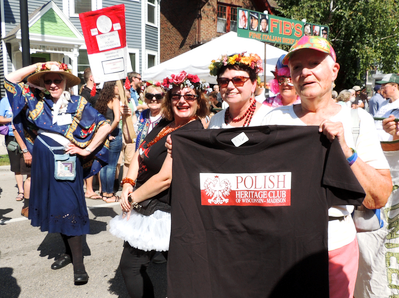October is the ....
POLISH HERITAGE MONTH
Polish American communities celebrate it since 1981.... read more



POLISH-RELATED EVENTS IN MADISON
OCTOBER 2018
October 5: Monthly PHC-Madison Breakfast
October 20: PHC sponsored screening of the historical epic "THE BATTLE OF WARSAW 1920"
Click on each line above to see details
See our calendar for more events
HIGHLIGHTS OF POLISH-RELATED EVENTS
IN MADISON AREA, SEPTEMBER 2018
September 7: Monthly PHC-Madison Breakfast
September 9: Polish Picnic in Devil's Lake
September 16: PHC-Madison in Willy Street Parade
September 19: Grażyna Auguścik & John Kregor concert
September 22: Polish Genealogy Workshop
September 28, 29 & 30: Emanuel Ax in MSO concert
Click on each line above to see details
See our calendar for more events
PHOTOS from the 2018 WILLY ST. FAIR & PARADE
A flurry of events scheduled for September is the best indication that the cucumber season (Polish sezon ogórkowy) has come to the end. In Poland, like in several other countries, this phrase refers to a slowdown in cultural and political life that still tends to occur in summer. Why are cucumbers used in this phraze is anybody's guess but they fit well the seasonal preoccupation with growing and preserving food for winter. Cucumber vines bear fruit all summer long (yes, botanically speaking, cukes are fruits and not veggies) and Poles love to make their delicious cucumber pickles in tradition that goes back before Christianity.
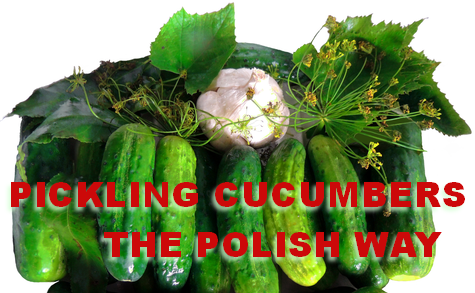
PICKLING CUCUMBERS THE POLISH WAY
It was a long way for cucumbers to reach Poland. Cultivated for over 4,000 years, the cucumber plant first spread from native India to China, the country still producing over 75% of the world's crop. The plant arrived to Europe via ancient Greece but it was the Romans who left behind numerous descriptions of its cultivation and conservation methods. Their favorite, pickling in salty brine (believed to originate either in China or Mesopotamia), spread through and beyond the vast expanse of the Roman Empire. Interestingly enough, the oldest archeological evidence of its use in Europe comes from Kraków and dates back to somewhere between A.D. 650 and 950.
Over 90% of cucumber crop in Poland (the 10th largest producer in the world) is preserved and the main difference between two major techniques used for this purpose is the use of vinegar. The most popular is the older, vinegar-free, salty-brine pickling technique that relies on the lacto-fermentation. In this process, friendly anaerobic bacteria convert sugars into lactic acid that inhibits the growth of harmful bacteria and molds. The second method is used in Poland since the XVIII-XIX century and takes advantage of the vinegar's conserving properties.
Ingredients for 1 quart jar
8 to 10 pickling cucumbers
1 heaping tablespoon of sea salt
1 quart of spring water, boiled
1-2 stems of dill plant, washed
3-5 cloves of garlic, peeled
several slivers of fresh horseradish root
several leaves of grape, cherry or oak
1 teaspoon mustard seeds (optional)
1 bay leaf & several peppercorns
Dissolve salt in boiled water and let it cool. Arrange leaves at the jar bottom. Tightly pack the cucumbers into the jar. Fill in the interspaces with folded dill and all other remaining ingredients. Pour the salt solution up to the brim making sure that all ingredients are fully immersed. Loosely cap the jar with a lid so that fermentation gases can escape and leave the jar in a dark place. The brine will slowly cloud and some of it may seep out, so place a jar on some dish to catch it. Depending on the room temperature, you will get ogórki małosolne in about 2-4 days. For ogórki kiszone, wait about 2-3 weeks. They will be ready when the brine clears.
Pickles made using these methods taste differently and have distinct names in Polish. Cucumbers treated with vinegar are called ogórki konserwowe or korniszony. Some people, though, reserve the second name for the very tiny vinegar pickles. Others use it only for pickles produced with a mix of both methods (salty brine soak before the vinegar finish).
Cucumbers fermented in salty brine are called ogórki kiszone or ogórki kwaszone. But read the fine print on commercial products because the second name might be used to describe a lower-quality pickles obtained by adding acid to artificially stop the fermentation process (the natural fermentation process takes about 2-3 weeks and comes to the end all by itself when the level of acidic components reaches 1.4-1.7 percent). Last but not least, ogórki małosolne (low-salt cucumbers) are basically a sweeter version of ogórki kiszone consumed after the first 2-4 days into the fermentation process.
Poles enjoy pickling cucumbers so much that competitions are held in various communities over the summer. Take for example Zielona Góra, where such contest became an annual attraction. Every summer, people gather to watch the pickling process and then two weeks later, to sample and judge the results (click here for video and photos). On the other hand, the citizens of Szczecin, launched the first "ogórki małosolne" championship this year, shortening the event's span to just three days (click here to see photos). Competitors guard their recipes closely, however, telling only that the secret to success is the right amount of salt in the brine and a good choice of other ingredients.
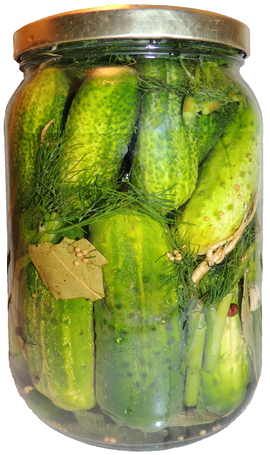 So, is it difficult then to make ogórki kiszone and/or ogórki małosolne? Not really if you have some understanding of the fermentation process. Therefore, in addition to the basic recipe (see the insert above), here is a list of pointers that can make your efforts more successful:
So, is it difficult then to make ogórki kiszone and/or ogórki małosolne? Not really if you have some understanding of the fermentation process. Therefore, in addition to the basic recipe (see the insert above), here is a list of pointers that can make your efforts more successful:
Cucumbers - pickling cucumbers are best to use because in comparison to the slicing varieties, their skin is less bitter and seeds smaller & less numerous. The cucumbers should be relatively small (up to 4-5 inches long). The larger ones tend to get mushy - or even empty inside - as they collect too much carbon dioxide released during the fermentation process. It's best to start with the freshly picked cukes before they lose their natural crispness. But if needed, pre-soaking in ice water for several hours can usually restore their firmness. Note also that cucumbers fertilized with too much nitrogen do not make good pickles.
Dill and other ingredients - Polish style pickles owe their delightful flavor to the right mix of dill, garlic and horseradish. The entire dill plant can be used including roots, stems, leaves and seeds. But flowers can be problematic because they have an enzyme that makes cucumbers mushy by speeding up decomposition. On the other hand, the crunchiness of pickles can be increased by adding tannin-containing leaves of such plants grapes, black currents, cherries, and even oaks. The brine is sometimes spiced up with mustard seeds - as well as peppercorns, bay leaves, all spice, coriander seeds and bay leaves- although purists argue that the latter spices should be used only for vinegar pickles.
Salt - never use the iodized salt because iodine inhibits the growth of beneficial bacteria. Avoid also salt that has other additives (like anti-caking agents in table salt or kosher salt - the latter might be also too harsh). The best is the sea salt made of evaporated sea water or mined from the ancient sea beds. Salt concentration in brine can vary between 20 to 60 grams of salt per liter of water (2.7–8.0 oz/US gal). Since salt slows the fermentation process, use less salt for quick, half-soured pickles (ogórki małosolne) and more salt for the fully-soured pickles (ogórki kiszone).
Water - spring or well water is best because chlorine in tap water kills the beneficial bacteria. Boil water for several minutes to remove as much dissolved oxygen as possible. Add salt to water only after boiling because evaporation will throw off (increase) the intended salt-water ratio and remove some micro-elements present in salt. Some recipes call for pouring hot brine over cucumbers but keep in mind that high temperature of both the brine and the air speeds up the fermentation process. According to most sources, it's best to cool the brine to room temperature, which should be about 60 – 75 degrees Fahrenheit.
Container - larger quantities of brine pickles are traditionally produced in oak barrels but stoneware crocks and glass jars are best for pickling at home. Ceramic crocks protect the pickles from light but glass jars are cheaper and more practical for two reasons. First, they let you see what's going on inside and second, you can vary ingredients slightly from one jar to another. Comparing the results will help you arrive at your favorite recipe or produce flavors that suit differing tastes of other family members. The glass jars must be clean but there is no need to sterilize them. One thing is essential though: All cucumbers and other ingredients must be completely submerged in brine to ensure the oxygen-free environment needed for the beneficial bacteria. Otherwise, things can go south very quickly.
Happy Pickling!!!
Upcoming events for September 2018:
September 6, 2018 6:30 P.M. in Polish Center of Wisconsin
JONES ISLAND KASZUBES AND THEIR SAINT STANISLAUS CONNECTIONS
(with representatives of the EMIGRATION MUSEUM in Gdynia, Poland)
Discussion moderators: Dr. Angela Pienkos, Prof. Anne Gurnack, St. Stanislaus Abbe George Baird, the Emigration Museum's Deputy Director Sebastian Tyrakowski and Chief Research Officer, Rafał Kaczyński.
Two articles worth reading before the discussion:
"Jones Island Fishing Village, 1898" by Jeff Beutner (2016)
"The story behind Kaszube’s Park: Milwaukee’s smallest, strangest piece of public land" by Tyler Maas (2017)
September 7-9 at Loyola University Chicago
75th Anniversary of Polish American Historical Association (PAHA)
The program, registration materials and other information about the 3-day conference celebrating PAHA's history and achievements are available on the PAHA website, PAHA NewsBlog and the letter from PAHA President, prof. Dr. Anna Mazurkiewicz. We remember her from "The Story of Polish and East European Exiles in the United States After World War II" she told the members of PAC-Wisconsin Division and other guests of Polish Center of Wisconsin in November 2017.
The annual picnic for the PHCwi members, families and friends
Sunday, July 22nd
Goodland County Park, Shelter #1
Click here for schedule, location
and volunteer opportunities
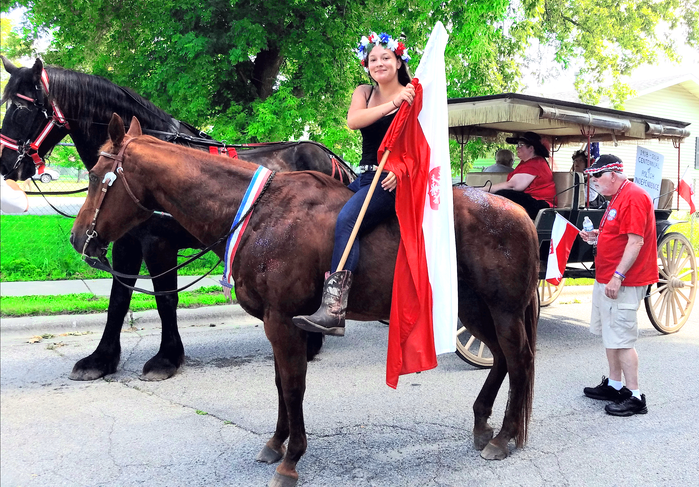
PHC members participated in the July 4th Parade in Evansville, WI
Edela Skotnicki paraded on Dakota, while Camille & Stefan Skotnicki (owners of the horses and the carriage), Jane Dunn, Gloria Welniak, and Paul & Marge Morgan greeted the parade onlookers from the carriage.
Some PHC members have been spotted also during the 2018 Polish Fest in Milwaukee (see the photo gallery below).
From the PHC's President, Alan Patek:
Vital organizations need to grow and develop. We have a great group, but how many people of Polish heritage don’t know who we are or know about the great activities that we sponsor? I’m asking all of you to help.
Between now and the end of November, take time to reach out to at least five new people of Polish background you know (friends, family, everyone). Tell them about the club and invite them to join our great group. For each new member (put your name as a referring member on their Membership Form), we will enter your name in a drawing for a free membership next year and a surprise gift.
Let’s show off the same Polish determination today that made our homeland’s rebirth possible 100 years ago. Let’s exceed our goal of increasing our membership by at least 10%.




